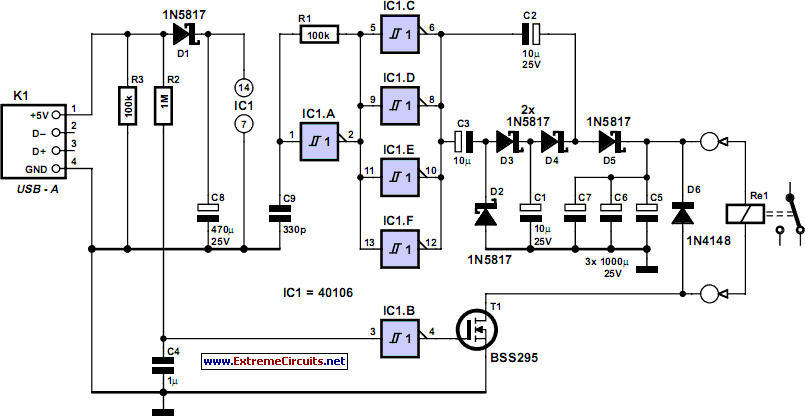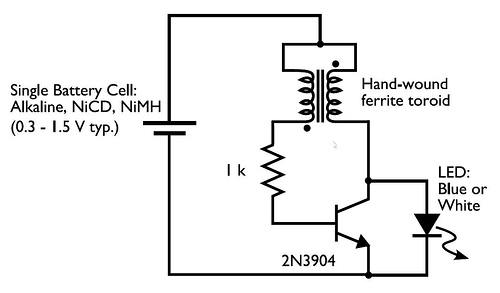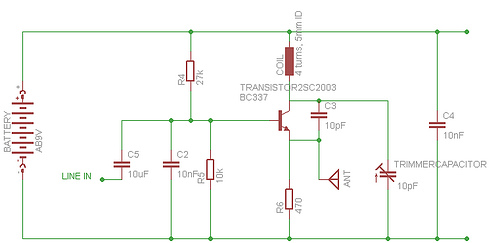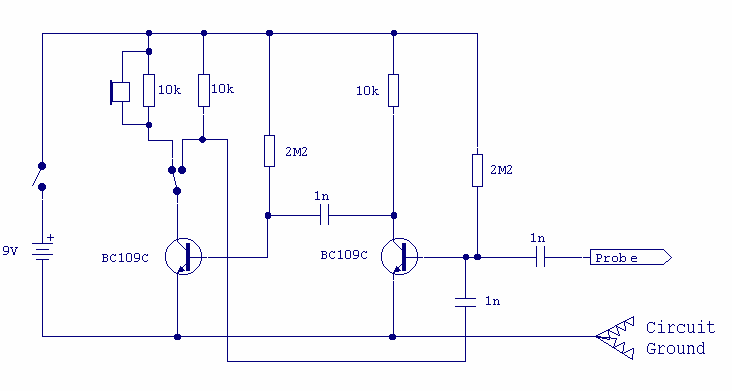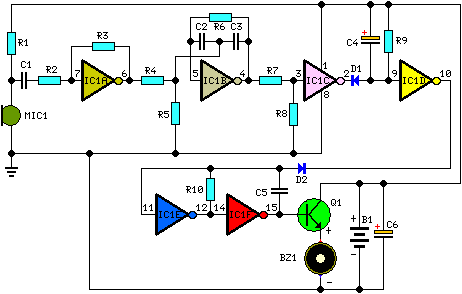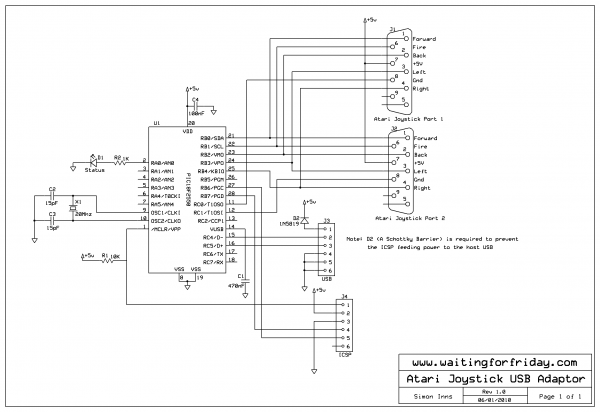
curve tracer adaptor schematics
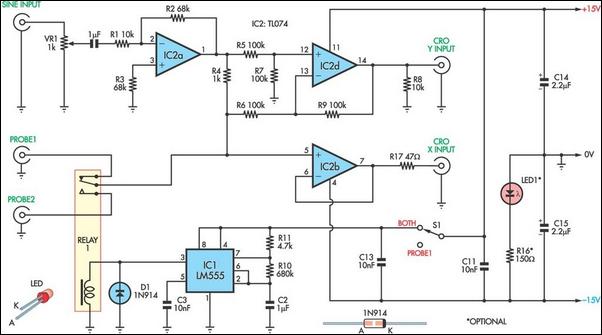
This unit utilizes a dual trace oscilloscope with X-Y functionality as a display to test and demonstrate the operation of circuits and components such as transistors, diodes, zener diodes, and both terminated and unterminated transformers. A low-frequency sine wave (e.g., 10Hz - 1kHz) is fed into operational amplifier IC2a through potentiometer VR1 to establish the "X" and "Y" levels for the X-Y display on the oscilloscope. The output from IC2a is directed to the X input via resistor R4 and operational amplifier IC2b, and also to Probe 1 through the contacts of relay 1. IC2b provides a low impedance drive for the X input and isolates the X input cable capacitance from Probe 1. The current flowing into the probes generates a voltage across R4, which is processed by IC2d and applied to the Y input of the cathode ray oscilloscope (CRO) to represent current. Consequently, the oscilloscope display represents an X-Y graph where the voltage across the circuit under test is displayed on the X-axis (horizontal) and the current through it is displayed on the Y-axis (vertical). With a calibrated oscilloscope, this corresponds to 1mA/V. An additional operational amplifier IC1 and a relay are incorporated to facilitate the use of two probes, allowing comparisons between a known good device and a faulty one. The relay should be a low capacitance reed type. By adjusting the X and Y gain controls on the oscilloscope, the sine wave applied to the device under test can be varied from a few millivolts up to 24V peak-to-peak, providing a highly useful display. Therefore, this unit can be employed on voltage-sensitive devices, while also being capable of applying sufficient voltage to test components such as a 10V zener diode. It is important to note that all devices should be tested in an unpowered state. If in-circuit tests are performed, the influence of other circuit components must be considered. Shielded coaxial leads should be utilized for the X and Y inputs, and the probe leads should possess zero resistance. Standard oscilloscope probes are not recommended, as they typically exhibit significant built-in resistance that could interfere with accurate measurements.
The circuit design integrates several critical components to ensure precise measurements and reliable operation. The dual trace oscilloscope allows for simultaneous observation of voltage and current, facilitating the analysis of circuit behavior under various conditions. The use of operational amplifiers IC2a and IC2b is pivotal in providing the necessary signal conditioning and isolation, which minimizes the impact of cable capacitance on the measurements. The relay system enhances the versatility of the testing setup by enabling quick switching between different probes, thereby allowing for comparative analysis without the need for extensive manual reconnections.
Moreover, the adjustable sine wave input is crucial for testing a wide range of devices, from low-voltage sensitive components to those requiring higher voltage levels for functional verification. The specification of using shielded coaxial cables and low-resistance probe leads emphasizes the importance of maintaining signal integrity and reducing noise interference, which are critical factors in accurate electronic measurements.
In summary, this oscilloscope-based testing unit serves as a comprehensive tool for evaluating the performance of various electronic components, providing essential insights into their operational characteristics while ensuring measurement accuracy through careful design considerations.This unit employs a dual trace oscilloscope with X-Y function as a display to test and demonstrate the action of circuits and components such as transistors, diodes, zener diodes, and terminated and unterminated transformers. A low frequency sinewave (ie 10Hz - 1kHz) is applied to op amp IC2a via potentiometer VR1 to set the "X" and "Y" levels for
the X-Y display on the scope. The output of IC2a is applied to the X input via R4 and IC2b and also to Probe 1 via the contacts of relay 1. IC2b provides a low impedance drive for the X input and also isolates the X input cable capacitance from probe 1.
The current flowing into the probes develops a voltage across R4 which is processed by IC2d and applied to the CRO Y input to represent current. The scope display thus represents an X-Y graph where voltage across a circuit under test is displayed on the X axis (horizontal) and the current though it displayed on the Y axis (vertical).
With a calibrated scope this equates to 1mA/V. IC1 and a relay are included to enable two probes to be used and comparisons made between a known good device and a faulty one. The relay should be a low capacitance reed type. By using the scope`s X and Y gain controls, the sinewave applied to the device under test should be adjustable from a few millivolts up to 24V peak-peak to get a very useable display.
Thus, the unit can be used on voltage sensitive devices and at the other end of the scale apply enough voltage to check the operation of, say, a 10V zener diode. Note that all devices should be tested in the unpowered condition. If used for in-circuit tests, the effects of circuit components will need to be taken into account. Shielded coax leads should be used for the X and Y inputs and the probe leads should have zero resistance.
Normal scope probes should not be used as these usually have significant built-in resistance which will interfere with measurements. 🔗 External reference
The circuit design integrates several critical components to ensure precise measurements and reliable operation. The dual trace oscilloscope allows for simultaneous observation of voltage and current, facilitating the analysis of circuit behavior under various conditions. The use of operational amplifiers IC2a and IC2b is pivotal in providing the necessary signal conditioning and isolation, which minimizes the impact of cable capacitance on the measurements. The relay system enhances the versatility of the testing setup by enabling quick switching between different probes, thereby allowing for comparative analysis without the need for extensive manual reconnections.
Moreover, the adjustable sine wave input is crucial for testing a wide range of devices, from low-voltage sensitive components to those requiring higher voltage levels for functional verification. The specification of using shielded coaxial cables and low-resistance probe leads emphasizes the importance of maintaining signal integrity and reducing noise interference, which are critical factors in accurate electronic measurements.
In summary, this oscilloscope-based testing unit serves as a comprehensive tool for evaluating the performance of various electronic components, providing essential insights into their operational characteristics while ensuring measurement accuracy through careful design considerations.This unit employs a dual trace oscilloscope with X-Y function as a display to test and demonstrate the action of circuits and components such as transistors, diodes, zener diodes, and terminated and unterminated transformers. A low frequency sinewave (ie 10Hz - 1kHz) is applied to op amp IC2a via potentiometer VR1 to set the "X" and "Y" levels for
the X-Y display on the scope. The output of IC2a is applied to the X input via R4 and IC2b and also to Probe 1 via the contacts of relay 1. IC2b provides a low impedance drive for the X input and also isolates the X input cable capacitance from probe 1.
The current flowing into the probes develops a voltage across R4 which is processed by IC2d and applied to the CRO Y input to represent current. The scope display thus represents an X-Y graph where voltage across a circuit under test is displayed on the X axis (horizontal) and the current though it displayed on the Y axis (vertical).
With a calibrated scope this equates to 1mA/V. IC1 and a relay are included to enable two probes to be used and comparisons made between a known good device and a faulty one. The relay should be a low capacitance reed type. By using the scope`s X and Y gain controls, the sinewave applied to the device under test should be adjustable from a few millivolts up to 24V peak-peak to get a very useable display.
Thus, the unit can be used on voltage sensitive devices and at the other end of the scale apply enough voltage to check the operation of, say, a 10V zener diode. Note that all devices should be tested in the unpowered condition. If used for in-circuit tests, the effects of circuit components will need to be taken into account. Shielded coax leads should be used for the X and Y inputs and the probe leads should have zero resistance.
Normal scope probes should not be used as these usually have significant built-in resistance which will interfere with measurements. 🔗 External reference
